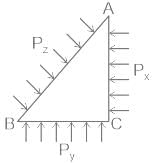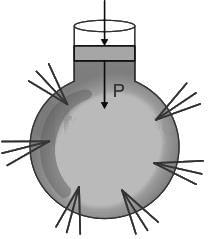Test: Pascal's Law - Civil Engineering (CE) MCQ
10 Questions MCQ Test Fluid Mechanics for Civil Engineering - Test: Pascal's Law
Assertion (A): Pressure is equal in all directions at a point in an ideal fluid flow.
Reason (R): Pascal's law is valid for all fluids.
Reason (R): Pascal's law is valid for all fluids.
Pascal's law states that pressure at a point is equal in all directions, in a
From the given image, which of the following statements are true according to Pascal's law?


A hydraulic press has a ram of 15 cm diameter and plunger of 1.5 cm. It is required to lift a weight of 1000 kg. The force required on the plunger is equal to:
A hydraulic press has a ram of 20 cm diameter and a plunger of 3 cm diameter. It is used for lifting a weight of 30 kN. Find the force required at the plunger.
Hydraulic ram is used for lifting heavy vehicles or items. What is the principle behind the application of hydraulic ram?
The pressure intensity at a point in a fluid is the same in all directions, only when the fluid
|
54 videos|96 docs|110 tests
|























